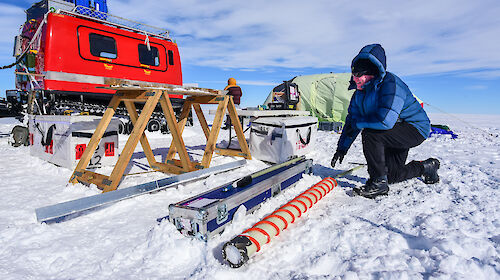The “summer” season began in the middle of the Antarctic winter with a voyage to investigate winter sea ice formation off Antarctica’s coast and ended with a voyage to all four Australian stations and the successful completion of major animal, ocean sediment and ice studies.
“We have worked over an area from Mertz Glacier (2,700 km south of Hobart) to Heard Island and Mawson in Antarctica, over 3,000 km to the west,” the Australian Antarctic Division's Chief Scientist, Professor Michael Stoddart said today.
Australian science was also represented in a biological program at Ross Island, 4,000 km from Hobart, and Campbell Island south of New Zealand, Professor Stoddart said.
“After the dislocation of the 1998–99 season, with ship breakdowns and other disruptions, we are delighted to have so fully realised our science objectives for the year and to end our last research season for the century (or our first for the new one) on such a high note,” he said.
The 1999–2000 season featured large-scale programs contributing to international data-collecting efforts, focusing on pack-ice seals, sea-ice formation and ocean floor sediments. It also included a range of long-term land-based and Southern Ocean research projects covering subjects as diverse as krill growth, upper atmosphere winds, emperor penguin population changes, Macquarie Island plant distribution, movement and mass of the Antarctic ice sheet, human immune responses, waste management in Antarctica, and the impact on penguin colonies of a human presence.
Mertz Glacier polynya study
Polynyas are open areas of ocean within sea-ice. A large year-round polynya off the Mertz Glacier, south of Tasmania, was the subject of a multi-disciplinary study by Australian scientists using the icebreaker Aurora Australis to penetrate the pack-ice in winter (July–August 1999). Such large polynyas are believed to have a major influence on ocean circulation. The voyage gathered an enormous amount of data on ice production, water composition and temperature, weather conditions and ocean currents. This information is still being analysed.
Pack-ice seal program
The international Antarctic pack-ice seals program, seeking to establish the abundance of Antarctica's crabeater seals, is one of the largest wildlife surveys ever undertaken. Australia was a major participant in the program, surveying about a quarter of the entire continental pack-ice. During the 1999–2000 season Australia undertook detailed ship-based and aerial surveys across over 3,000 kilometres of the Southern Ocean in the outer Antarctic pack-ice. Results of the survey are being collated and analysed.
Ocean floor drilling
Scientists in the research ship Tangaroa undertook an international ocean drilling program in the waters off the Antarctic coast south of Tasmania. The voyage gathered numerous sediment cores, undertook seafloor photography, and obtained large quantities of seismic data. A large sea-floor deposit discovered during the voyage contained a 10,000-year history of the sea ice cover and ocean currents. The historical data provided by the geological survey will support the Mertz Glacier polynya data.
Other 1999–2000 highlights
- The successful collection of krill during the summer is facilitating studies into the animal's biology at the Kingston experimental krill aquarium.
- Continuous plankton recorder surveys have shown that for most of the year the open ocean has much higher diversity and abundance of species than the marginal sea ice zone.
- The distribution of plants on Macquarie Island appears to be related to the large differences in soil nitrogen composition.
- Successful testing of a hot water ice drill at the Amery Ice Shelf was excellent preparation for a major drilling program there in coming years.
- Climate change studies provided new evidence of the state of balance of the vast Lambert-Amery ice drainage basin, suggesting that ice is accumulating in the basin.
- New expertise and technology is being utilised in studies of human immune responses using tissue specimens collected in Antarctica, a ground-based analogy to long-term space flight.
- Biological studies of Adélie penguins have been integrated with geographical records of penguin distribution to help prepare guidelines for operation of helicopters in Antarctica.
- A toxicity test based on the development of sea urchin embryos indicates that Antarctic species may be susceptible to pollutants at lower concentrations than temperate species.
- Australia and other Antarctic Treaty member nations are required to clean up sites of past activities. Australia’s effort is focused on abandoned stations at Heard Island and Wilkes. Heritage assessment work was begun at Heard Island, and at Wilkes, scientists measured the level of contamination to help determine whether removing waste may affect the local environment.
- A radar system at Australia's Davis station is enabling winds to be measured high in the Earth’s atmosphere with unparalleled accuracy.
- An Australian-Japanese study has shown that precursors to major storms in the Earth's magnetic field can be found in cosmic ray records.

